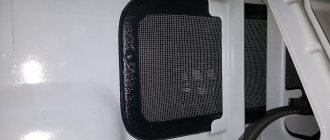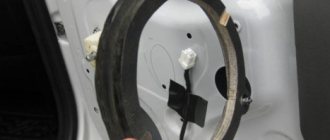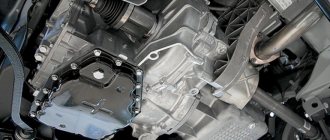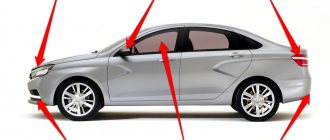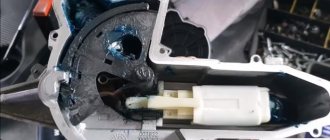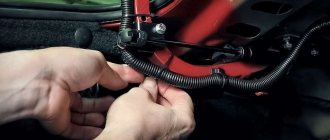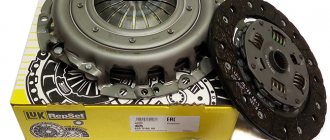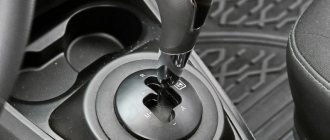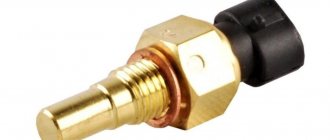Just a few years ago it was impossible to imagine the presence of a non-manual gearbox on Lada cars. Now a four-speed automatic transmission, a CVT and an AMT robot are being installed, which will be discussed further.
Menu
- Device
- Principle of operation
- Advantages
- Flaws
- Application
- Results
The AMT robot appeared in 2014. This version is called AMT-1 or VAZ-21826. In 2022, the firmware was rewritten and the name AMT-2 or VAZ-21827 was changed.
Device
Structurally, the AMT is a conventional five-speed manual transmission VAZ-2180, equipped with actuators from ZF for clutch release and gear shifting.
A - clutch actuator; B — gear shift actuator; B — clutch fork; G - speed sensor on the input shaft.
Clutch actuator
1 - drive gear; 2 — clutch fork rod; 3 — wear compensator; 4 - compensation spring; 5 - electric motor.
Gear shift actuator
1 — gear selection rod; 2 — gear shift drive; 3 — gear selection drive; 4 - electric motors.
General information about the AMT robot
- The mechanical part is based on a five-speed modification of the VAZ model 2180 gearbox. Moreover, this gearbox is equipped with gear pairs with different output ratios for different Lada models. For example, the Vesta box has this output indicator of 3.9, when, as on Grants and Kalinas, it is 3.7.
- You cannot take an actuator (clutch pressing mechanism) and robot electronics and put it on a regular box of the same VAZ 2180 model so that the result is a robot. Although the reverse procedure of replacing a robot with a mechanical one can be carried out with overcoming some obstacles.
- It is believed that the actuator cannot be repaired or maintained, but this is not for our craftsmen. Cases of its failure, judging by the reviews, are very rare. Usually, they happened at the beginning of operation, while still under warranty. There were no cases of refusal to replace.
- The recommendation to change the oil in the AMT at a mileage of 120 thousand does not stand up to the criticism of mechanics; they recommend doing this at 75 thousand mileage.
- The adaptability or adaptability of the transmission to changing operating conditions of the engine and its load, the position of the gearbox engaged mode sensors (ECP), as well as the gas and brake pedals is ensured by reading the sensor information and analyzing this information. And based on the algorithms embedded in the robot’s program, a certain order of its actions is formed. In this case, the driver’s actions in various situations are taken into account, which are stored in the robot’s long-term memory. If we say all this in a simple and understandable language for everyone, then the AMT transmission adapts to the characteristics of the driving style of a particular driver and road conditions. Moreover, for this she usually needs a couple of tens of kilometers of driving in the city.
- The AMT robot is sensitive to engine load and quickly responds to the activation of maximum torque. At the same time, each subsequent gear can be engaged only when the engine speed drops below 2.5 thousand, and each subsequent one when the range from 4 to 4.5 thousand revolutions is reached. In addition, the degree of load perceived by the engine is taken into account. For example, on a slope, the AMT robot will switch to a lower gear if the load on the engine decreases, but will leave it in the most economical operating mode.
- AMT has its own peculiarities of operation in accordance with the established transmission modes. For example, in “M” mode, the gearbox switches faster compared to “A” mode.
Principle of operation
In automatic mode, the actuators themselves change gears and depress the clutch depending on engine speed.
There is also a manual mode, where the driver himself will change gear when he needs it, and the actuator is responsible for squeezing the clutch. In this mode, the automatic system still monitors the engine and, when it reaches very high speeds, will change gear itself in order to avoid damage to the gearbox.
All about AMT. Behavior after break-in.
Good afternoon, dear Dromovites!
What made me write this general post is the fact that most people discussing the disadvantages/advantages of the AMT Vesta do not have a detailed understanding of this transmission.
First, some general information:
1. The AMT is based on a modified VAZ 2180 manual transmission. 5 speeds. In the Vesta AMT the gear ratio of the main pair is 3.9; on Kalinas and Grants it is 3.7. On AMT Kalina 120 km/h corresponds to 3000 rpm. per minute, Vesta: 3,150-3,200.
2. You can’t just take and “screw” a “canopy” of actuators and an electronics unit to a regular VAZ 2180 manual transmission to get an AMT output. In terms of hardware, the AMT differs from the manual transmission by a modified housing, a different input shaft with a rotation sensor + a few more “little things” (this is in brief).
3. The ZF actuator unit is maintenance-free. Estimated service life is 10 years. The current cost is about 20 thousand rubles. Not a single failure of this unit has been recorded yet.
4. “Clutch assembly” AMT modified (relative to manual transmission). The cost of replacement at the moment is about 5.5 thousand rubles. from the officials. Its service life depends on the driver for the most part. AMT tries to take care of him (behaves like a “retired” driver). No failures were noticed during early runs (up to 30 thousand km). There are no routine adjustment work until its “death.” In theory, it should last at least as long as an ordinary driver (not a racer!)). On average it is about 100 t.km. during urban use.
5. Oil poured into the AMT is not officially subject to replacement until 120 thousand km. Unofficially, engineers advise changing to 75 t.km.
6. AMT on cars with ESP (Vesta and, more recently, Kalina) is additionally tied to the ESP and HSA system (slope holding system. That is, in turns, AMT “holds gear” without allowing a break in the power flow between the wheels and the engine .
7. AMT - adaptive transmission. Every second (or rather, each cycle of execution of the main program of the AMT controller. This is several tens of ms), its controller reads data from the engine control units, ESP (ABS), gearbox sensors, gas and brake pedals in order to form the necessary actions according to the interference of the basic gear shift maps and variables from long-term memory (where the driver’s actions in certain situations are recorded and dynamically adjusted).
In non-technical terms: the box adapts to the driver's driving style and road conditions. To do this, she needs time (according to my observations, this is several tens of kilometers in the city).
8. Kick-down mode is always available. However, in the “M” mode, if the first gear is engaged, the AMT will not switch to a higher gear until the driver swings the lever to the “+” position (from the second and higher it will shift at the cutoff).
9. AMT quickly detects an increased load (slope or towing someone) and uses the maximum possible engine torque. Those. drives “on the spot”: switches this way. so that the next gear is engaged at least 2.5 t.r.o. per minute and switches to the next gear when it reaches at least 4 - 4.5 rpm. in a minute. The applied torque depends on the amount of load on the engine: for example, on a slight slope, the AMT will simply switch to a lower gear, but will not crank it up, remaining in the economical gear shift corridor.
10. In “M” mode, AMT changes gears faster (about 150-250 ms) than in “A” mode. When the speed decreases (when the engine speed in the selected gear drops to idle), the AMT will automatically engage a lower gear. Accordingly, when reaching maximum speed - increased (with the exception of the first: see point 8).
Differences between AMT versions:
1. On Priors, Grants and Kalinas without ESP there is no slope retention system.
2. On Westas, shifts are softer and smoother (in “A” mode) than on Viburnums and others like them. But the shifts are slower. They have different calibrations and software settings.
Operational features of AMT:
1. There is no separate “P” (“parking”) mode. But the AMT can be left in gear. To do this, you need to turn off the engine in modes “A” or “R”. With the engine off, you can move the AMT lever to the “N” position, the gear will remain engaged. The next time you turn on the ignition, the clutch will open automatically (i.e., you will need to press the brake pedal to prevent the car from rolling away).
2. The car starts only when the brake pedal is pressed and the AMT lever is in “N” position. Autostart can be implemented in the same way as on cars with manual transmission.
3. All versions of AMT do not have a “creeping” mode. The car will start moving only when you press the gas pedal.
4. During long stops (for example: before a railway crossing), it is advisable to move the AMT lever to the “N” position. Those. act in the same way as a driver with a regular manual transmission. When mode “A” or “R” is turned on and the gas pedal is not pressed, the clutch is open and there is a load on its release bearing.
5. Engine braking is possible, but slowly (in higher gears). AMT quickly includes lower gears.
However, I was convinced from my own personal experience. that it is better to assist engine braking with the brake pedal.
6. During smooth braking (with the brake pedal), the AMT additionally brakes with gears, but during intense braking, the AMT opens the clutch (there is a feeling that there is a small “sink” in the brake pedal).
7. After heavy braking, the clutch will remain open until the gas pedal is pressed. Those. after pressing the gas pedal there will be a pause before acceleration (necessary for smooth closure of the clutch disc). It lasts about 0.5 seconds. When braking smoothly, the pause is shorter or absent.
8. When you hit the brake pedal sharply, the BAS (Brake Assist) system is activated even before the ABS is activated. The clutch will immediately open.
Next, I summarize the impressions and characteristics of AMT behavior in various conditions.
-==1. Run-in.==-
Immediately after leaving the car dealership, any normal driver will get used to driving a car. This is also true for short test drives of a car that has not yet been broken in. And most likely AMT mode “A” will be used. Therefore, he is unlikely to start “giving heat” with the gas pedal. AMT will switch as smoothly as possible (i.e., also slowly, but there will be a separate paragraph about switching speed below) and when it reaches 2-2.5 rpm. As you might guess, this will cause the first reaction - “Robot is Stupid!!!”. In the editors of Droma, this term is called “robot freezes.”
In order to “stir up” the robot, you need to press the gas pedal more actively. The 21127(9) engine, although with variable intake manifold geometry, is never TSI with its maximum torque available from 1500 rpm. per minute Therefore, during the break-in period, it is worth turning the engine in the city. Preferably up to 3000 rpm. per minute in first gear. Then the AMT will work noticeably faster.
From first impressions: you can drive like a regular automatic: holding down the gas pedal until the required speed is reached. During smooth acceleration, the dives are unnoticeable; shifts feel like a gust of headwind on the highway. The switching speed directly depends on the main operating mode of the AMT combination and the engine, i.e. During the break-in period, these switchings are not as fast as after its completion. The switching time ranges from 0.8 to 1.5 seconds.
On an AMT without an HSA system, the car rolls back on a slope. Those. when you quickly move your foot from the brake pedal to the gas pedal, the car can roll down several tens of cm (depending on the magnitude of the slope). This needs to be taken into account. I usually just move my foot, but on some slopes I work “with two feet”: I press the brake with my left and smoothly press the gas with my right. With this method, there will be no rollback: as soon as the AMT feels the presence of a slope (with the brake pedal already released), the engine speed and the degree of slip of the clutch disc are immediately adjusted. It is impossible to stall on AMT.
I'll quote myself:
“In a smooth flow, the robot works slower (in the sense of changing gears). That's noticeable. Let’s say if you drive like a classic automatic, holding a certain speed, then the shifts are noticeable from first to second and from second to third. Shifts to fourth and especially fifth are almost imperceptible. How does the switching feel: when switching to second (by default it occurs somewhere at 2.5 tons of rpm), the robot disengages the clutch, forcibly reduces the speed and engages the clutch. It's like a gust of headwind on the highway. Switching takes about 1 second. From second to third everything is the same, only it switches a little faster (it feels like about 0.7-0.8 seconds) and smoother. You can still feel the shift to fourth, but it switches to fifth imperceptibly.
AMT operation, some features:
1. You can tell the robot to change gears using the gas pedal. To do this, when you reach the required speed for switching, slightly reduce the pressure on the gas pedal (as if you lower the engine speed on a conventional manual) for about half a second. While the revolutions were dropping (i.e. in the same 0.5 seconds), the robot had already stuck into the next gear. Tested several times, very comfortable switching.
….
5. On the track, the robot maintains gear and speed. Those. There is some kind of cruise control: even if you completely remove your foot from the gas pedal, the revs remain for some time and the speed does not decrease. I had to get used to this. Without pressing the brake pedal, the car does not slow down (at least this applies to flat sections of the road without a slope).”
-==2.Traffics==-
In traffic jams, you need to divide them into their type:
1. Standing traffic jam. Those. drove 5 meters and stopped. In this mode, I didn’t bother working with the gas pedal at all: I pressed the gas smoothly, the car always moved off equally smoothly, I released the gas pedal and the car rolls until it stops either by itself or with the help of the brake pedal. And so on until next time. If the plug is dead, then when stopping, move the AMT selector to the “N” position. If not, then in this mode there are no differences from the machine (except for the absence of a “creeping” mode).
2. Smoothly creeping cork. Those. Then you stand for a minute, then you drive for half a minute (or vice versa). The speed is walking speed. In this mode, the following feature of AMT was revealed (I will quote myself again):
“When driving in a very sluggish traffic jam, AMT requires a very gentle press on the gas pedal.
Let me explain: if I were driving a manual, 1st gear would be constantly engaged and there would periodically be “too much” at idle. Those. I would periodically squeeze the clutch and brake. AMT in this case does the same: i.e. When the gas pedal is released in first gear, it releases the clutch. The point is that when coming to a complete stop, the AMT always starts off equally softly, but if the car is still rolling and you need to accelerate slightly, then when you add gas, the AMT takes a pause and the driver instinctively adds a little more gas (as if instead of 1200-1300 rpm .per minute you give 1400-1500). Then the AMT comes to its senses and allows the clutch to close. It turns out to be a small push in the back.
It was established experimentally (what else to do in a traffic jam? :-)) that the treatment is quite simple: you need to not increase the speed so sharply. It's corny, but it works. Those. AMT clearly monitors not only the position of the gas pedal, but also the rate of change of this position.”
-==3.Gear shift speed==-
This is one of the most difficult points. And probably one of the most discussed in AMT's work. So how long does it actually take to change gears? It feels very fast after running in. In crawling mode through traffic jams, running in is significantly slower.
Let us turn to the research of the Autoreview magazine from their following article:
https://www.autoreview.ru/_archive/section/detail.php?ELEMENT_ID=151068&SECTION_ID=8190
Without thinking twice, I took the following graph from this article:
In this graph, I highlighted the period of time when the clutch is completely open and the actuators directly change gear. For AMT Kalina this time is about 0.33 seconds, for Vesta this time is longer: about 0.5 seconds.
If you look at the curves for the drop and rise in torque, you can see how quickly the clutch opens on the AMT of the Viburnum and how much slower it makes the AMT of the Vesta. However, this is even more relevant for the clutch engagement curve: the AMT viburnum spends another 0.2 seconds to engage (smoothly, I note! Even with the gas pedal fully depressed!) the clutch until the point of crossover between the torque lines of the clutch and the engine, from this point the engine torque is already transmitted on the wheels, but the clutch will still slip. It will turn on completely in 0.35 seconds.
To summarize: the time when torque from the engine is not transmitted to the wheels is about 0.53 seconds for AMT Kalin\Grant\Prior.
For AMT Vesta, the following figures are relevant: 0.5 for switching + 0.5 before the transmission of torque to the wheels begins + 0.1 s for full activation.
The guys from Auto Review measured the total time for shifting gears from the beginning of the clutch disc opening until it is completely closed. In this case it is 1.45 s. for viburnum and 1.72 for Vesta.
However, it seems to me that what is important is not the total shift time, but the time from the clutch disc opening until the next gear begins to supply engine torque to the wheels. After all, it is precisely this moment that we all feel (as if “grabbed by the butt.” This is especially true for the most intense acceleration). During smooth acceleration, these transitional moments are not felt at all. Even when switching from the first to the second (see my previous addition with the first video).
In “M” mode, you can subtract the disc opening time from the total gear shift time; it occurs almost instantly. And the disk closes much more fun. The switching time itself is also reduced by about 100 ms (which AMT spends on determining the required gear). But all the same: the shifting is comfortable, without shock engagement of the gear and shock engagement of the clutch. So AMT is still not made for “racing” (but you can fool around :-)).
-==4.After running in=—
I'll start by describing the sensations. The points:
1. AMT switches have become timely and fast. The robot adapted to me, and I adapted to it.
2. I stopped using the “M” mode. I don’t see much point in it under normal operating conditions (without “off-road”), I force the robot to switch when I want. Only sometimes on slopes does he helpfully change gears and over-throttle so that I can continue driving “on the fly.”
What should you do to prevent the “robot from being stupid”:
1. During a smooth start, if you suddenly unexpectedly (for AMT) decide to “spur the horse” at the moment of switching from first to second, do not press the gas all the way. Still, this will not help you change gear faster. But when the second one turns on, the acceleration will be linear and quite noticeable (unless, of course, you release the gas pedal). Therefore, if you decide to start abruptly, just bluntly press the gas. AMT will accelerate as efficiently as possible (within the limits of grip and engine power, of course) with minimal switching time from first to second, etc.
2. In traffic, try to accelerate within the current gear: this will allow you to make maximum use of the engine torque over a wide range. Tell the robot when to switch with the gas pedal. Then the robot quickly adapts to your driving style.
3. Do not forget that you can only switch from neutral to “A” (or “R”) with the brake pedal depressed. Although you can switch from “A” or “R” to “N” on the fly without pressing the pedal.
Thank you. that you read this sheet to the end! :-) I hope that you found it interesting.
Advantages
- Cheapness. AMT is more profitable to produce than an automatic or CVT, so the end buyer gets cars with a robot at a lower markup.
- Efficiency The efficiency of the AMT robot is comparable to that of a manual transmission. The power loss from gear operation is about 2%.
- Unlike the driver, the robot's actuators try to extend the life of the box, and changes gears more slowly and smoothly than a human could. Therefore, switching to higher gear occurs with some delay, which increases fuel consumption.
- There is an imitation of a creeping mode, like on an automatic transmission (VAZ-21827).
Lada cars with AMT reviews from owners
Most often, owners of cars with such a manual transmission complain about delays or jerks when switching. They are especially noticeable when driving in city traffic or when starting up a hill. Sometimes this robot generally behaves inappropriately, sometimes it will drop several gears for no reason, sometimes, on the contrary, it drives for a long time and strainedly at high engine speeds, without even intending to shift.
The second inconvenience is the lack of a rolling mode, as on a hydromechanical automatic transmission, which is so convenient in traffic jams. When a car slowly crawls in automatic mode, after releasing the brake pedal, everyone expects that they will move on, because the gearbox is in gear. But no, you need to press the accelerator. Update: version 21827 received a rolling mode.
Application
- Lada Vesta (2180)
- Lada Vesta (2181)
- Lada Vesta Cross
- Lada Vesta Cross (2181)
- Lada Granta (2190)
- Lada Granta (219059) Drive Active
- Lada Granta (2191)
- Lada Granta (2192)
- Lada Granta (2194)
- Lada Granta Cross (2194)
- Lada Kalina (2192)
- Lada Kalina (2194)
- Lada Kalina Cross (2194)
- Lada Priora (2170)
- Lada Priora (2171)
- Lada Priora (2172)
- Lada X-Ray
Which models are equipped with an AMT gearbox?
This robot is installed on Lada cars only with 16-valve power units:
Lada
| Vesta sedan 2180 | 2015 - present |
| Vesta SV 2181 | 2017 - present |
| Vesta Cross 2180 | 2018 - present |
| Vesta SV Cross 2181 | 2017 - present |
| Granta sedan 2190 | 2015 - present |
| Granta hatchback 2192 | 2018 - present |
| Granta liftback 2191 | 2018 - present |
| Grant station wagon 2194 | 2018 - present |
| Granta Cross 2194 | 2019 - present |
| X-ray hatchback | 2016 - present |
| Priora sedan 2170 | 2014 — 2015 |
| Priora hatchback 2172 | 2014 — 2015 |
| Priora station wagon 2171 | 2014 — 2015 |
| Kalina 2 hatchback 2192 | 2015 — 2018 |
| Kalina 2 station wagon 2194 | 2015 — 2018 |
| Kalina 2 Cross 2194 | 2015 — 2018 |
Replacing clutch grant robot
The main distinguishing feature of an automated transmission (AMT or “robot”) from a mechanical one is the electric actuators produced by ZF, which change gears at the command of the electronic “brains”. The manufacturer claims that the actuator unit is maintenance-free and cannot be repaired, but craftsmen have found a way to repair it with their own hands.
If the car’s warranty has already expired, then replacing the clutch release mechanism actuator yourself will cost tens of thousands of rubles (article numbers: 21820160901200 and 21820170501200). In an attempt to save money, you can try to repair it.
Replacing the AMT clutch actuator
How to remove the actuator
:
- Disconnect the negative terminal of the battery.
- The engine air filter has been removed.
- Remove the screw securing the wiring harness.
- Remove the three screws securing the AMT actuator unit.
All that remains is to disconnect the connector (press the fasteners, the direction is indicated by the arrow) and pull the actuator out through the top.
Installation
in reverse order.
Also, the process of removing and installing the clutch release mechanism actuator is described in TI 3100.25100.20583 (download).
Is it fair to install AMT robot in X-Ray
If you want to buy a car with a robotic gearbox, regardless of the make and model, but in the middle price category, you should pay attention to the operational features of the above-mentioned unit.
A striking example would be the Lada X-Ray with the latest generation robot from similar automatic transmissions. The combination of technology with the simplicity of the car raises a lot of questions among the average consumer. If you understand them gradually, you can understand all the advantages, and come to terms with some of the disadvantages. Thus, a review of the X-ray fret will help you understand how effective the AMT robotic gearbox is, as well as in what driving modes it does not cause discomfort when switching.
In the video below you will find answers to the following questions:
- How to change gear if the car was turned off in neutral.
- How the X-Ray robot reacts to sharp gas when changing lanes.
- How the elongated main pair is displayed on the dynamics (how the gear ratios are selected, in comparison with Renault gearboxes).
- Can AMT be heard in the cabin (a huge difference from the Granta).
- Lever position when using manual shift mode.
Driving performance test
Considering that the car has a fairly powerful engine, it provides good dynamic performance in the city. In this case, even the AMT robot plays to the driver's advantage. When overtaking, the gear is pulled out for as long as possible, which allows you to safely complete the maneuver. When moving downhill, the “speed” always remains on, which is convenient for subsequent continuation of movement.
In the manual mode of using the box, completely different sensations are achieved, making it possible to understand when to release the gas to switch. In any mode of the box, the “prompt” on the dashboard continues to work.
Considering the high-torque power of the 1.8-liter engine, you can drive within one gear, which will be comfortable for overtaking and driving in traffic. A visual comparison in the realities of a busy road gives an overall impression of how the AMT robot on X-Ray, and the entire machine as a whole, works.
For a more detailed test of the “box – car” connection, see the video below. Let's drive around the city, check the operating modes of the gearbox, how much the 1.8 engine installed under the hood of the domestic crossover is enough for it. The author will share his emotions from using a car with a similar robot in city mode. What you don't like and what you have to put up with in everyday use.
Video test drive of the AMT box on X-Ray:
Disassembling the AMT clutch actuator
Unscrew the top cover. We “discharge” the actuator (turn the gear as in the video) and remove the cover (do not open without the clutch load).
Remove the white compensator (Caution! The spring is very powerful!). The thrust rod is simply removed with force.
When assembling, carefully “cock” the mechanism (photo 1 - unloaded, photo 2 - cocked).
There is no need to make any adjustments to the clutch actuator after installation on the vehicle.
Step-by-step instructions for replacing the Lada Granta clutch
1. Put the car on a lift and remove the gearbox.
2. Next, if you do not change the clutch basket, you need to check the marks on the flywheel.
3. Unscrew the six bolts securing the basket to the flywheel. As you unscrew the bolts, hold the flywheel with a mounting blade (or a screwdriver).
eight open-end wrench .
4. Carefully remove the clutch basket from the engine flywheel and the driven disk.
5. Now you need to remove the release bearing. To do this, use a flat-head screwdriver to pry up the ends of the spring that holds the bearing.
6. After removing the spring from the guide bushing, remove the release bearing along with the clutch.
7. Now we finally remove the spring that held the release bearing.
8. If you need to replace the clutch fork or bushing, you need to pry up the rubber boot and remove it.
9. Next, remove the fork bushing from the clutch housing.
10. Lifting the clutch fork up, remove it from its seat and remove it from the clutch housing. If necessary, we make a replacement.
11. Let's start assembling the clutch. First, wash the entire clutch part in kerosene and replace everything that needs to be replaced.
12. Apply CV joint-4 grease to the guide sleeve of the release bearing as well as to the splined part of the input shaft. Don't overdo it, apply a thin layer of lubricant.
13. We install the removed parts of the clutch housing:
- release bearing
- clutch fork
- spring
- bushing
14. Next you need to center the clutch. To do this, use special. frame that needs to be inserted into the hole in the end of the crankshaft.
15. Place the driven disk on the frame so that the protrusion on the hub faces the gearbox.
16. Install the clutch basket.
17. If you made marks, then combine them and tighten the bolts with a torque of 19-31 Nm.
18. Remove the centering frame and reinstall the gearbox.
AMT clutch actuator repair
Clean the inner surface with solvent. Let's examine the insides. In this example, wear on the ball stops and a crack on the plastic part of the actuator were detected. The problem is that there are no repair kits. That is, AMT clutch actuator parts are not sold separately. If you cannot restore the old ones, all that remains is to lubricate the mechanism.
LIQUI MOLY Thermoflex Spezialfett was used as actuator lubricant. It is very similar to the one that was in the actuator from the factory. Read more about actuator lubrication here.
We perform reassembly and installation of the AMT actuator on the car (see above).
Let us remind you that if other malfunctions occur in the operation of the AMT (howling, crackling, the car jerks, jerking, rattling, etc.), you can determine the cause using these instructions.
Features of running in with a robot
In the reviews, especially from those who recently got behind the wheel of a Lada with an AMT robot, there is a lot of talk about how the robot is supposedly “dumb.” But there is a simple explanation for this supposedly “freezing” AMT. In the process of getting used to a new car, any driver, even impudent in other cases in relation to cars, does not “fall”, so to speak, with all his weight on the gas pedal.
He tries to drive the car like a pensioner, driving at low and medium speeds. Moreover, if, according to the AMT gear shift conditions, each subsequent gear is engaged when the engine reaches 4.5 thousand revolutions, then in this case this driver will not wait for the AMT to engage an upshift. This is the whole reason for the “stupidity” of AMT. In response to such statements, one can suggest that such drivers first “use” their brains, and then give the car gas. And immediately everything will fall into place.
Specifications
| Manufacturer | Autoconcern "AvtoVAZ" |
| Start year of release | 2021 |
| Volume, cm³ | 1596 |
| Power, l. With | 90 |
| Torque, Nm | 143 |
| Compression ratio | 10.5 |
| Cylinder block | cast iron |
| Number of cylinders | 4 |
| cylinder head | aluminum |
| Cylinder diameter, mm | 82 |
| Piston stroke, mm | 75.6 |
| Number of valves per cylinder | 2 (SOHC) |
| Timing drive | belt |
| Turbocharging | No |
| Hydraulic compensators | No |
| Valve timing regulator | No |
| Lubrication system capacity, l | 3.2 |
| Oil used | 0W-40, 5W-40 and 5W-30, 10W-40 |
| Fuel supply system | injector, multipoint injection (MPI) |
| Fuel | gasoline AI-92 |
| Environmental standards | Euro 5 |
| Resource, thousand km | 200 |
| Location | transverse |
5 AMT transmission service
According to the manufacturer, the 5 AMT transmission does not require maintenance, its elements are protected from dust and moisture, which in turn has secured the transmission’s reputation as a simple, reliable, trouble-free mechanism.
However, it is recommended to adhere to the following rules:
- Monitor the oil level; mechanical damage to the box may cause it to leak;
- Adapt the robotic gearbox clutch in a timely manner.
The box is a set of gears controlled by a ZF actuator. The clutch of the box wears out over time and needs to be adjusted to the actuator, this process is called adaptation, it is designed to eliminate jerks and shocks when moving.
Adaptation is carried out:
- Every 15,000 km of vehicle mileage;
- In case of clutch replacement;
- When updating the on-board computer settings.
The process is simple and takes a few minutes: the car is connected to the AvtoVAZ computer through a special diagnostic connector, the electrician turns on the program and directly communicates with the manufacturer’s server. The data is downloaded to the server, after which the engine starts and adaptation occurs within a few seconds.
It is advisable to have the box diagnosed by an official representative, since the work will require special equipment and trained personnel.
In August 2012, sales of the Lada Grant with automatic transmission began; it was the first AvtoVAZ car to have an automatic transmission installed as standard on the assembly line. Almost three years later (in March 2015), sales of the Lada Grant with AMT (automated manual transmission) began. Let's talk about the differences between these two transmissions, which can also be installed on Lada Kalina, Priora, Vesta and XRAY. What are their pros and cons, and which car is better to choose?
